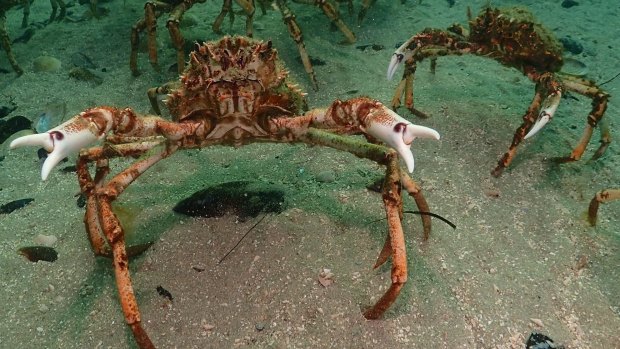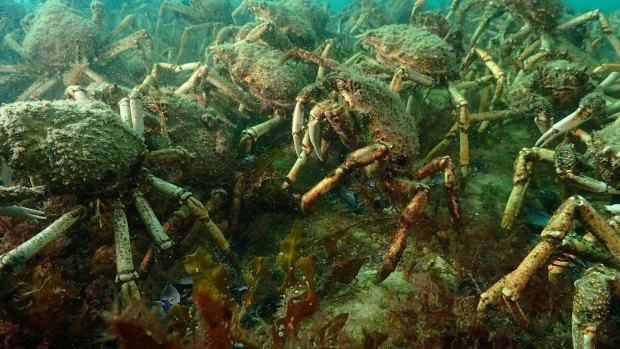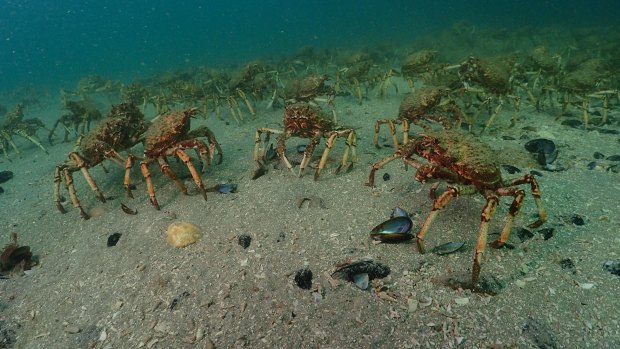This was published 4 years ago
Spider crabs in Port Phillip Bay: Crab army invades Melbourne as annual moulting process peaks
By Catherine Best

Thousands of spider crabs have invaded Port Phillip Bay for their annual moulting process.Credit: Jonathon Stevenson
They're here. An army of spider crabs, sometimes the size of a football field, is on the march in Melbourne's Port Phillip Bay. The creepy crustaceans are scurrying into shallow waters en masse for their annual shell-shedding soiree. The undersea spectacle sees tens of thousands, sometimes hundreds of thousands, of crabs congregate for a simultaneous striptease as they grow a new winter wardrobe.
The phenomenon peaks around the first full moon in winter, which happened on Monday, and triggers a feeding frenzy as stingrays, seals, birds and other predators binge on one of nature's biggest known smorgasbords of soft-shell crab. All this plays out in about two metres of water, offshore from Australia's second-largest city.
David Attenborough has documented it, divers and scientists rave about it, but most Melburnians have no idea that one of the world's great wildlife aggregations is occurring not too far from where they sleep. That's partly because most of the moulting action happens at night.

Some swarms can measure up to a metre deep as the crabs climb on top of each other, forming great underwater walls.Credit: Jonathon Stevenson
Parks Victoria chief conservation scientist Dr Mark Norman has been diving with spider crabs on and off for 30 years and says the phenomenon is as big an event as the mass spawning of corals in the Great Barrier Reef. Some swarms can measure up to a metre deep as the crabs climb on top of each other, forming great underwater walls.
"The mystical component of it is that it's in the cold of winter, it's largely unseen; the fishermen on the pier don't realise that that giant black stain over the sand is not seaweed it's actually crabs. This stuff's mainly happening at night, but it's been quietly going on for probably millions of years."
Dr Norman says the congregation is about safety in numbers, as the crabs are extremely vulnerable when they crack open their exoskeleton and "come out in their undergarments". It can take up to 12 hours before their new shell is hard enough to offer any protection. During that time, they flop around in an "empty onesie", drifting "like a flat origami crab" at the mercy of predators.

Predators binge on one of nature's biggest known smorgasbords of soft-shell crab during the process.Credit: Jonathon Stevenson
"It becomes a fascinating environment to watch tens to hundreds of thousands of crabs go through this process, mainly at night, while being pigged out on by seals, dolphins, cormorants, pacific gulls, stingrays, skates. You get stingrays swimming past with stomachs bulging out like they're nine months pregnant, it's completely full of soft crabs. Eventually they get sick to death of crab bisque .... and 95 per cent of the population wobbles off on their soft pink legs out into the deep channels again."
This year's mass aggregation centres around Blairgowrie Pier and has been building for a couple of weeks. Rye is another regular hot spot for spider crabs. At its peak, swarms of crabs can be seen from the pier, but for hardcore enthusiasts, diving below the water delivers box-seat viewing, even if the sea is a chilly 7C.
In the carpark of the Blairgowrie Yacht Squadron, John Noonan is among a cluster of brave divers, clad in 7mm wetsuits, hoods, gloves and booties. "It was one of the best dives I've done, a cornucopia of wildlife," the Mentone local beams, water dripping from his forehead as he strips off layers of neoprene at the back of a four-wheel drive.
He just might be right. In the water, clusters of crabs cling to the pier's wooden undercarriage, frequently dropping to the sand like an arachnophobe's worst nightmare. Empty carapaces quiver on the seabed, the odd leg floats in the current and a fat pufferfish chomps into a carcass. Huge short-tailed stingrays patrol the sand, snuffling up against an artificial ledge, under which scores of leggy crustaceans hide. There's a long flash of white as an opportunistic cormorant streaks across the ocean floor, seemingly as agile in water as in the air.
There are also cuttlefish and a few small Port Jackson sharks lurking. But no strip-teasing spider crabs. That will happen later, under the cover of darkness.
Sign up for the Traveller Deals newsletter
Get exclusive travel deals delivered straight to your inbox. Sign up now.